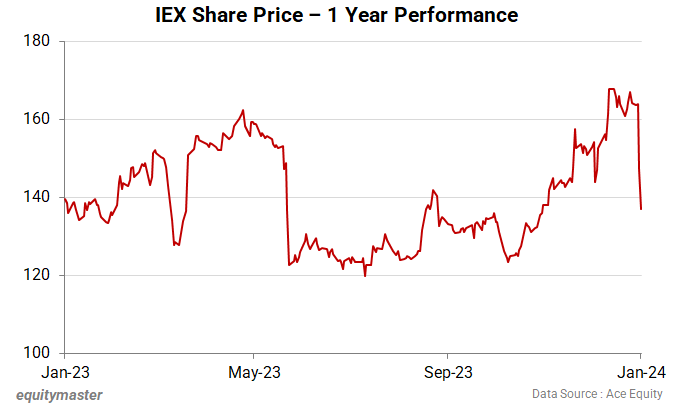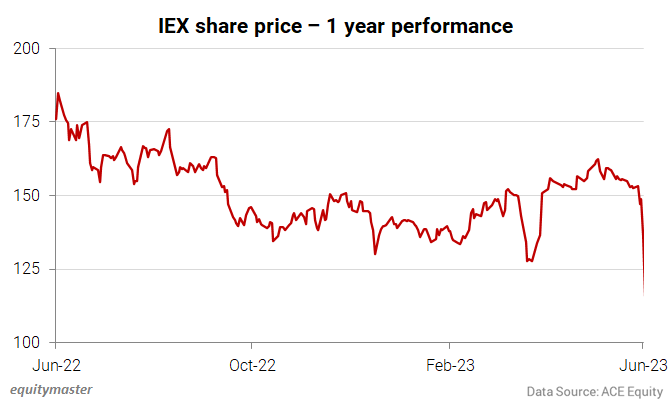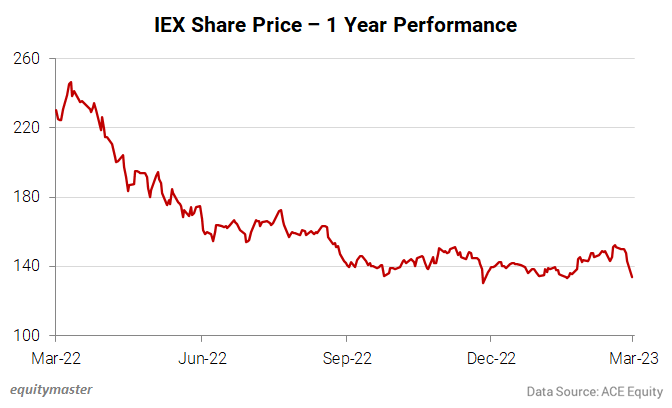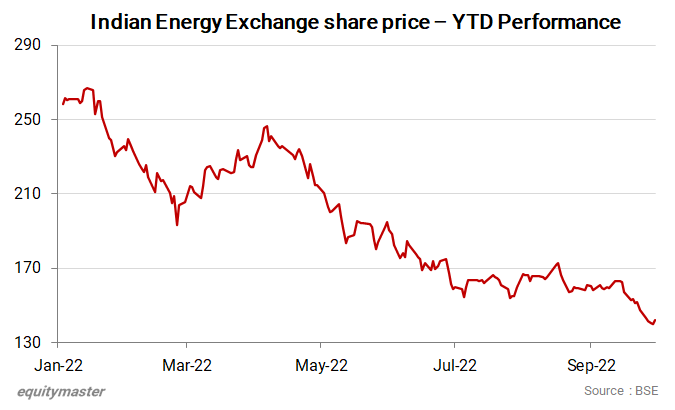India's Third Giant Leap
This Could be One of the Biggest Opportunities for Investors
- Home
- Views On News
- Jan 18, 2024 - Why IEX Share Price is Falling
Why IEX Share Price is Falling

Editor’s note: One of the top monopoly stocks in India - Indian Energy Exchange (IEX) - is facing a tough time for the past couple of months.
Shares of IEX fell 10% on 17 January 2024 which was followed by another 7% fall in the next trading session.
In the past five days, the stock has fallen over 17% while its YoY performance shows flat returns.

The recent fall comes after investors were once again worried about market coupling.
Investors are worried about IEX losing its monopoly status in the market once the market coupling mechanism is implemented.
But what many investors don’t know is that market coupling, apart from increasing competition within the exchanges, would also optimise the transmission allocation at the national level and enhance efficiency of power markets in the country.
In other words, IEX will no doubt lose volumes in the near term to the other exchanges. But the sharp rise in power exchange volumes over time will more than compensate IEX for the loss of market share.
Back in June 2023, IEX share price was experiencing a similar downtrend and investors were selling the stock in panic.
We covered a detailed editorial explaining the reasons behind the fall and what investors could expect.
Continue reading...
Why IEX Share Price is Falling (June 2023)
How often do you see shares of a company with a high-quality business struggle for a long period of time? People say you can't keep a good player down for too long but that's not always the case.
Take the case of Indian Energy Exchange (IEX), one of the top power companies in India by growth that is also India's first and largest energy exchange.
Shares of the company have been under pressure for some time now. In the calendar year 2022, IEX shares declined 35%. In 2023 so far, IEX share price is down 17%.

Most of the losses have come in the past five sessions with IEX shares falling around 32%.
Let's find out what happened and what the company could do to improve its fortunes.
Market coupling
Earlier this month on 2 June 2023, a circular was released which noted that the Power Ministry has directed Central Electricity Regulatory Commission (CERC) to undertake the process of consultation and implementation of market coupling in a timely manner.
To break down this in simple terms, the exchanges would be reduced to just a bid aggregation platform. The price discovery, which has always remained IEX's moat, would be done by a super exchange, most likely a government entity.
Currently, IEX enjoys monopoly in Day-Ahead Market (DAM) and Real-Time-Market (RTM) segments, which contributes to 75-80% of the exchange volumes.
According to experts, this is a big negative for IEX as it will potentially take away IEX's moat of being the most dependable platform price determination. Analysts say volume growth will be further impacted.
What next?
Reacting to the above circular, shares of IEX declined around 10% in late deals yesterday to end near 52-week low.
Today again, shares declined another 15% to touch a new 52-week low of Rs 116.
I won't bore you with all the details about the market coupling here - you can read the specifics of it across the mainstream media.
But here's what Tanushree Banerjee, Co-head of Research at Equitymaster, has to say about it -
- Now the biggest concern is whether the market coupling will dramatically reduce IEX' market share and take away its moat.
Market coupling, apart from increasing competition within the exchanges, would also optimise the transmission allocation at the national level and enhance efficiency of power markets in the country.
In other words, IEX will no doubt lose volumes in the near term to the other exchanges. However, the sharp rise power exchange volumes over time will more than compensate IEX for the loss of market share.
If the share power exchanged goes up 5 times from 6% to 30% by the end of the decade, IEX will be a huge beneficiary even if its market share falls from 90% to say 60%.
For now, pricing is the only reason affecting IEX shares, which the market is already factoring for a long time. IEX shares came under pressure earlier this month after its pricing fell 30% in May 2023.
The price during May 2023 was Rs 4.74 per unit, declining 30% YoY from Rs 6.76 per unit in May 2022.
The company is coming off a buyback plan where it bought back 4.9 million shares at Rs 200 per share.
Over the next decade, it aims to cash in on the clean energy megatrend. IEX recently launched India's first gas exchange, Indian Gas Exchange, and is working on launching a coal exchange.
It has also received approval from the Petroleum and Natural Gas Regulatory Board (PNGRB) to commence domestic gas trading on its platform.
This development will help IGX fulfil its commitment to increase the sell side liquidity, along with creating more opportunities for the sale of domestic gas and the discovery of a unique price.
It is also working with the Ministry of Coal to explore options for setting up a Coal Exchange.
Moreover, the growth potential is also huge given India's low per capita consumption and also how little the power consumed in India trades on exchanges. But there are things like competition and frequent government intervention that can cause a dent in the long-term story of IEX.
To conclude on a cautionary note, you're going to read a lot about the market coupling over the next few days. Some may say IEX is in the right while others would tell you that the negatives would prevail for a long time to come.
While I have no clue how it will play out, you can check out Tanushree Banerjee's note to her subscribers (requires subscription) on what she has to say about the circular.
These regulatory issues can get very complex quickly so be on the lookout. Reports say that CERC would first have to prepare a draft paper and hold consultations.
To know more about IEX, watch the below video where Rahul Shah talks about the opportunity in IEX.
Interestingly, IEX share price was experiencing a similar downtrend back in March 2023. And the reasons back then were different.
Continue reading...
Why IEX Share Price is Falling (March 2023)
After tumbling over 35% in 2022, shares of power trading platform IEX, have fallen again.
Shares of IEX fell for the eighth consecutive session on Tuesday, 28 March 2023. In intraday trade, IEX shares were down as much as 4%. The stock has crashed around 12% in the last eight sessions.
It succumbed to selling pressure amid reports that the Dalmia Group could trim its stake in the company.
Dalmia Group holds 14.8% stake in IEX through 3 entities. The group plans to further reduce its stake in the company and finally exit.
However, this is not the only reason why IEX share price is falling.
The company experienced pressure in the past as well. Back in October 2022, we wrote a detailed editorial explaining the reasons behind the underperformance of IEX.

Continue reading to find out more and what lies ahead for the company.
Why IEX Share Price is Falling (October 2022)
Yesterday, I visited a friend's house. She recently gave birth to a baby girl. The little one is absolutely adorable. Her elder brother kept watching her with a mixed feeling of adoration and wariness.
So when the two of us were alone, I asked him if he was excited to have a younger sibling. He said he was but he was also concerned that his parents will give his little sister more preference than him.
This happens to all elder siblings, doesn't it? An elder sibling feels the most threatened when a younger sibling is born.
Later on, they might turn out to be best of friends but initially, they feel threatened.
This is exactly what is happening with Indian Energy Exchange (IEX).
After delivering multibagger returns, IEX share price has bitten the dust as if its monopoly has threatened.
IEX share price reached its 52-week high price on 19 October 2021 and ever since then the share price has seen a sharp fall. On a YTD basis, IEX's share price has fallen by 45%.

Let us first understand what IEX does.
About IEX
The IEX is an Indian electronic system-based power trading exchange regulated by the Central Electricity Regulatory Commission(CERC). IEX started its operations on 27 June 2008.
It pioneered the development of power trading in India and provides an electronic platform to the various participants in the power market, comprising state electricity boards, power producers, power traders and open access consumers (both industrial and commercial).
Ever since its incorporation, it has held an influential market share, more than 90%. IEX operates a day-ahead market based on closed auctions with double-sided bidding and uniform pricing; it has over 3,800 registered clients, over 300 private generators and more than 3,300 industrial electricity consumers.
Out of the power exchange market open to power exchange companies, IEX had a 95% share in the market. It's a classic monopoly stock but this position was threatened recently, which caused IEX's share price to fall.
IEX to lose monopoly?
Only two companies - IEX and Power Exchange India (PXIL) were operating in the power exchange sector. Hence, IEX had a monopoly.
CERC was concerned about this. Hence it was expected that very soon another power exchange may come into existence to rob IEX of its monopoly status.
Around four years ago, Hindustan Power Exchange (HPX) was incorporated to be the third power exchange company. After 3 years of approval and all the procedures, HPX finally started its operation on 6 June 2022.
HPX is promoted by PTC India Ltd, Bombay Stock Exchange, and ICICI Bank.
Backed by three reputed companies HPX may threaten the market share of IEX. This has caused the share price to take a share fall.
Poor quarterly results
To add insult to the injury, IEX reported poor quarterly results.
For the quarter that ended 30 June 2022, IEX reported a total income of Rs 1,134 m. It is 12% lower as compared to last quarter. It reported a net profit of Rs 686 m which is 21% lower quarter on quarter (basis).
This hurt the market sentiment, and the fears that HPX will rub off on the financials of IEX turned out to be true.
Hence fuelled by the fire of IEX losing its standing in the market, share price has come crashing down.
To know more about IEX, check out its quarterly financial results.
Update: For the quarter ended 31 December 2022, IEX reported dull numbers. IEX reported a 4% YoY decline in its December quarter consolidated net profit to Rs 772.1 million (m).
On a consolidated basis, revenue for the quarter increased by 3.1% sequentially.
Trading volumes were impacted largely due to supply-side constraints, led by high prices of e-auction coal.
With volumes declining for consecutive quarters, IEX's near-term future is uncertain because its margins have come under pressure and the entry of HPX has added concerns.
FII Selling
Interest rates are rising in developed markets like the USA. This makes the emerging markets less attractive for FIIs because the risk-free rate of return reduces.
Hence FIIs sell their holdings in companies operating in emerging markets like India to return to the safety of dollars. The same has happened with IEX.
FIIs have been divesting their stake in IEX since September 2021. FII's stake stood at 37.7% in the quarter ending December 2020.
The stake was reduced to 20.8% by the end of June 2022 quarter. This stake sale by FIIs added insult to the injury.
For more, check out IEX's latest shareholding pattern.
Update: FIIs continue to remain bearish on the stock. Take a look at the table below to see what percentage of their stake they have sold over the past few quarters:
| Quarter ending | Mar-21 | Jun-21 | Sep-21 | Dec-21 | Mar-22 | Jun-22 | Sep-22 | Dec-22 |
|---|---|---|---|---|---|---|---|---|
| FII Holding (%) | 29.62 | 36.81 | 36.66 | 37.74 | 31.01 | 27.07 | 20.77 | 15.79 |
IEX Buyback
In November 2022, IEX announced a buyback worth Rs 980 million (m) representing approximately 14.95% and 14.92% of the aggregate of the fully paid up equity share capital and free reserves.
Total size of the buyback is up to 490,000 m shares or 0.55% of total number of fully paid up equity shares on a proportionate basis.
The price for tendering shares would not exceed Rs 200 per share. At the current price, the buyback price is at a 40% premium.
Since buybacks interest you, check out our editorial on 5 companies that could announce big buybacks.
Final Words
Competition isn't always bad. Healthy competition is one of the secrets of success.
For instance, big corporate houses Tata, Ambani and Adani are competing hand in hand, just to make India a superpower in various aspects.
Hence, the entry of HPX will boost the performance of IEX, because while HPX may threaten to take away the market of IEX, the power exchange market is expanding.
Out of the total power exchange market, only 7.6% market consists of temporary power purchase agreements (PPA) rest of the market was owned by permanent PPA. Power exchange companies were only allowed to sell 11 days' contact i.e. temporary PPA.
However, recently the CERC approved the introduction of additional term-ahead and green term-ahead contracts beyond T+11 days (T indicates zero days of trading).
Hence, currently, power exchange companies only have 7.6% market open to them. But slowly gates to the bigger markets are also opening to them.
Also, in the past five years, IEX's annual financial performance has improved. Its sales and operating profits have grown at a CAGR of 28% and 15% respectively. Take a look at the chart below.
Financial snapshot
| Particulars (Rs in m) | FY18 | FY19 | FY20 | FY21 | FY22 |
|---|---|---|---|---|---|
| Total Income | 2,560 | 2,941 | 2,971 | 3,573 | 4,778 |
| Growth | 10.0% | 14.9% | 1.0% | 20.3% | 33.7% |
| Operating profit | 2,105 | 2,429 | 2,445 | 2,997 | 4,179 |
| Operating profit margin | 82.2% | 82.6% | 82.3% | 83.9% | 87.5% |
| Net profit | 1,316 | 1,650 | 1,779 | 2,134 | 3,025 |
| Net profit margin | 51.4% | 56.1% | 59.9% | 59.7% | 63.3% |
Hence IEX may be losing small but, it can win big in the long haul. It has a lot of growth potential and capability.
However, its short-term future may be uncertain because its margin may initially be under pressure because of the entry of HPX.
Happy Investing!
Investment in securities market are subject to market risks. Read all the related documents carefully before investing
Out Now
3 High Conviction Stocks
Chosen by Rahul Shah, Tanushree Banerjee and Richa Agarwal
Report Available
Details of our SEBI Research Analyst registration are mentioned on our website - www.equitymaster.comDisclaimer: This article is for information purposes only. It is not a stock recommendation and should not be treated as such. Learn more about our recommendation services here...
FAQs
Which are the top power companies in India?
Based on marketcap, these are the top power companies in India:
- #1 NTPC
- #2 POWER GRID
- #3 ADANI POWER
- #4 ADANI GREEN ENERGY
- #5 TATA POWER
You can see the full list of the BSE power stocks here.
Also check out our detailed analysis of the top power stocks in India.
Which are the top gainers and top losers within the power sector today?
Within the Power sector, the top gainers were KEI INDUSTRIES (up 5.3%) and SJVN (up 4.0%). On the other hand, URJA GLOBAL LTD. - (RIGHTS ISSUE) (down 10.1%) and ADANI GREEN ENERGY (down 8.2%) were among the top losers.
For more, please visit the BSE power index live chart and also check out our power sector report.
How should you value power companies?
Investing in stocks requires careful analysis of financial data to find out a company's true worth. However, an easier way to find out about a company's performance is to look at its financial ratios.
Two commonly used financial ratios used in the valuation of stocks are -
Price to Earnings Ratio (P/E) - It compares the company's stock price with its earnings per share. The higher the P/E ratio, the more expensive the stock.
Price to Book Value Ratio (P/BV) - It compares a firm's market capitalization to its book value. A high P/BV indicates markets believe the company's assets to be undervalued and vice versa.
To know more about the power sector's past and ongoing performance, have a look at the performance of the BSE Power Index.


Equitymaster requests your view! Post a comment on "Why IEX Share Price is Falling". Click here!
Comments are moderated by Equitymaster, in accordance with the Terms of Use, and may not appear
on this article until they have been reviewed and deemed appropriate for posting.
In the meantime, you may want to share this article with your friends!